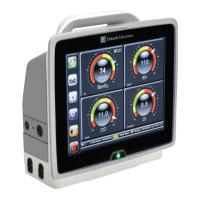34
HemoSphere Advanced Monitor 2 Safety and Symbols
• Inaccurate cardiac output measurements may be caused by: • Incorrect placement or position of
the catheter • Excessive variations in pulmonary artery blood temperature. Some examples that
cause BT variations include, but are not limited to: * status post cardiopulmonary bypass surgery *
centrally administered cooled or warmed solutions of blood products * use of sequential
compression devices • Clot formation on the thermistor • Anatomical abnormalities (for example,
cardiac shunts) • Excessive patient movement • Electrocautery or electrosurgical unit interference
• Rapid changes in cardiac output (chapter 9)
• Refer to Appendix E to ensure computation constant is the same as specified in the catheter
package insert. If the computation constant differs, enter the desired computation constant
manually. (chapter 9)
• Sudden changes in PA blood temperature, such as those caused by patient movement or bolus drug
administration, may cause an iCO or iCI value to be computed. To avoid falsely triggered curves,
inject as soon as possible after the Inject message appears. (chapter 9)
• Do not use any FloTrac sensor or TruWave transducer past its labeled “Use By Date.” Products
used beyond this date may have compromised transducer or tubing performance, or compromised
sterility. (chapter 10)
• The effectiveness of FT-CO measurements in pediatric patients has not been evaluated. (chapter
10)
• Inaccurate FT-CO measurements can be caused by factors such as: • Improperly zeroed and/or
leveled sensor/transducer • Over- or under-damped pressure lines • Excessive variations in blood
pressure. Some conditions that cause BP variations include, but are not limited to: * Intra-aortic
balloon pumps • Any clinical situation where the arterial pressure is deemed inaccurate or not
representative of aortic pressure, including but not limited to: * Extreme peripheral
vasoconstriction which results in a compromised radial arterial pressure waveform * Hyperdynamic
conditions as seen in post liver transplant • Excessive patient movement • Electrocautery or
electrosurgical unit interference Aortic valve regurgitation may cause an over estimation of Stroke
Volume / Cardiac Output calculated depending on the amount of valvular disease and the volume
lost back into the left ventricle. (chapter 10)
• Always grasp the connector, not the cable, when connecting or disconnecting the cable. (chapter 10)
• Do not twist or bend the connectors. (chapter 10)
• Make sure that the oximetry cable is securely stabilized to prevent unnecessary movement of the
attached catheter. (chapter 11)
• The catheter and the calibration cup must be dry for an accurate oximetry in vitro calibration. Flush
the catheter lumen only after the in vitro calibration has been completed. (chapter 11)
• Performing an in vitro calibration after the oximetry catheter has been inserted into the patient will
yield an inaccurate calibration. (chapter 11)
• The SQI signal is sometimes affected by the use of electrosurgical units. Attempt to distance
electrocautery equipment and cables from the HemoSphere advanced monitor and plug the power
cords into separate AC circuits if possible. If signal quality problems persist, call your local Edwards
representative for assistance. (chapter 11)
• Do not disconnect the oximetry cable while calibration or data recall are in process. (chapter 11)
Status = Released Printed Date: 2018-01-16 Released Date: 2017-09-14

